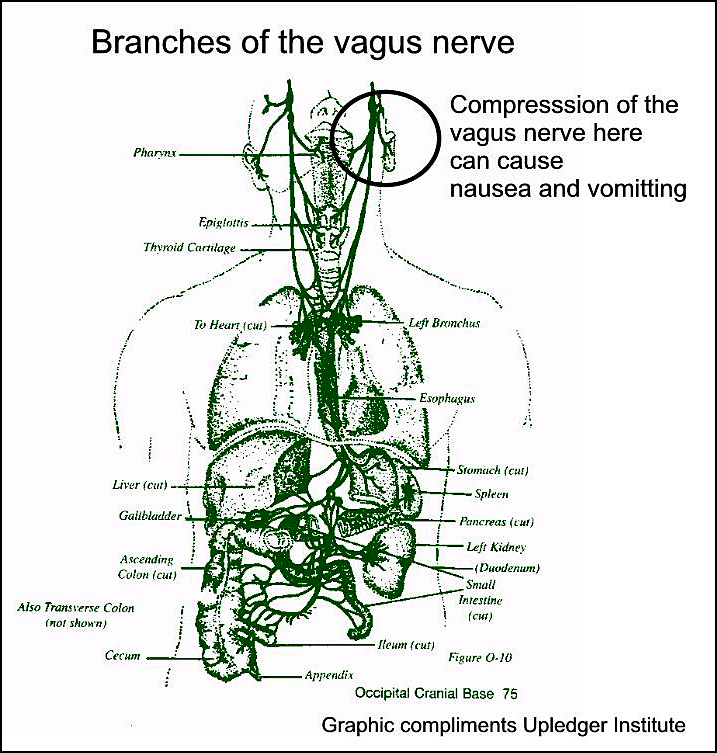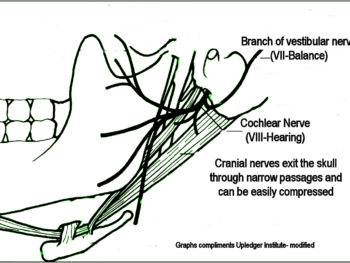Cyclic vomiting is devastating condition that involves episodes or cycles of severe nausea and vomiting that last for hours, or even days, and alternate with intervals with no symptoms. Episodes can be so severe that a person has to stay in bed for days, unable to go to school or work. There are no tests—such as a blood test or x ray— that can establish a diagnosis. Doctors first rule out other common diseases or disorders that can cause nausea and vomiting. Then a pattern of vomiting must be established. Since there is no cure, medications are used to manage the symptoms. Treatment is usually based on trial and error. So this makes medical treatment of cyclic vomiting comparable to that of Meniere’s disease and so-called vestibular migraines.
Despite being a medical mystery cyclic vertigo appears to be easily resolved with cranio – sacral therapy.
A 15 year old girl I saw some years ago was diagnosed with cyclic vomiting. The young woman had suffered from periodic bouts of headaches, dizziness, nausea and vomiting since the age of seven. All of the symptoms occurred concurrently. Medical treatment had not been able to help her. The mother approached me because she knew of my work with vertigo.
I had never encountered cyclic vomiting before but it sounded like it could very well be a craniosacral problem, so I asked the mother lots of questions. Did the vertigo last for hours rather then seconds? Did she have hearing loss? Ringing in the ears? The later symptoms are all related to Meniere’s disease, an allegedly incurable condition of the inner ear. The girl had, in fact, been previously diagnosed with Meniere’s.
All the girl’s symptoms pointed to a compression of the temporal bones of her skull. The temporal bones are the paired bones on either side of the head to which our ears are attached. When misaligned or moving erratically the temporal bones can compress the balance and hearing nerves as well as create pressure and abnormal movement of the fluid in the inner ear causing vertigo and other symptoms. I reasoned that if the temporal bones were compressed they might also be restricting the vagus nerve which would account for the nausea and vomiting.
Although the vagus nerve is small as it exits the skull, it quickly branches out to connect with numerous organ s throughout the body. These include the pharynx, larynx, esophagus, stomach, intestines, the heart and lungs. The vagus nerve exits the skull at a tight opening between the temporal bone on the side of the head and the occiput which is the bowl-like bone that forms the bottom of the skull. I had already found that temporal bones problems could cause nausea and bouts of vomiting. This was the first time I had encountered continuous vomiting.
s throughout the body. These include the pharynx, larynx, esophagus, stomach, intestines, the heart and lungs. The vagus nerve exits the skull at a tight opening between the temporal bone on the side of the head and the occiput which is the bowl-like bone that forms the bottom of the skull. I had already found that temporal bones problems could cause nausea and bouts of vomiting. This was the first time I had encountered continuous vomiting.
What I found on the initial evaluation, not surprisingly, was compression of the temporal bones on both sides of the head along with some other cranial restrictions. During the session all of the involved cranial restrictions loosened considerably, but I thought, not enough to completely relieve the symptoms. In fact, in the days immediately following the session there was a major reduction in headache intensity, some nausea but no vertigo or vomiting. One or two more session undoubtedly would have resolved the symptoms completely, but for some reason the young woman was reluctant to continue craniosacral therapy. The girl’s mother told me some years later that there had been no more incidents of vomiting and that the occasional headaches, dizziness and nausea were mild. Why the girl refused to come back for more treatments is a mystery to this day.
Conclusion
Although headaches, dizziness, and vomiting, are usually not serious, they can sometimes be indications of a more serous condition. Always see your doctor to rule out serious medical causes before seeking craniosacral therapy.